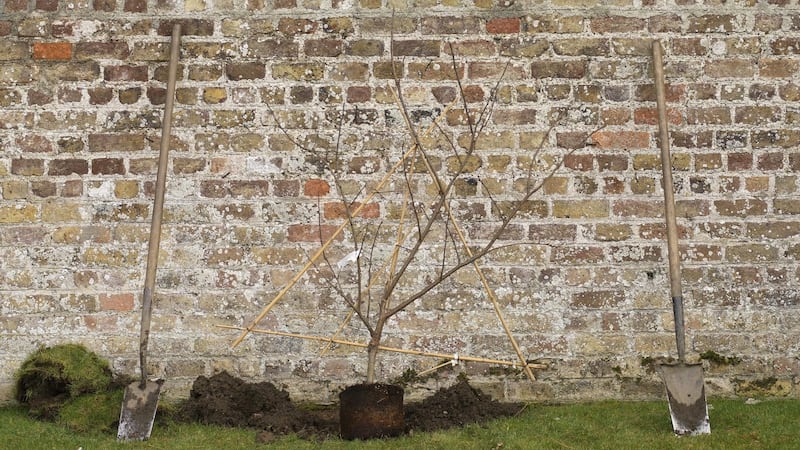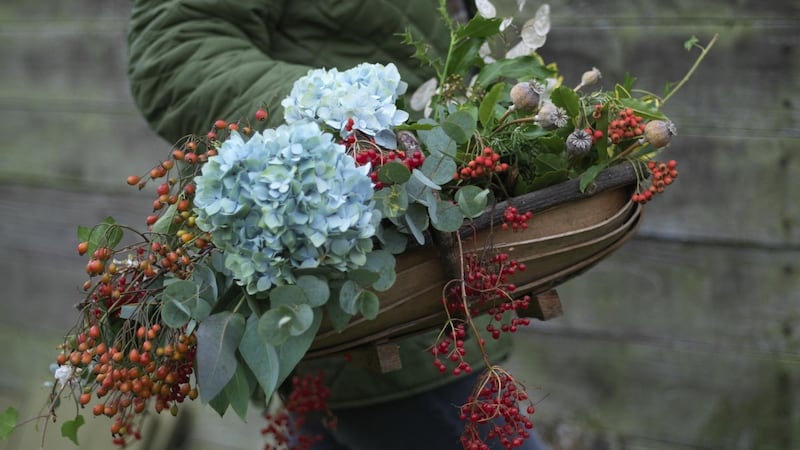When is the best time to plant a tree?
So goes the proverbial question, to which the killer punchline of a proverbial answer – “Twenty years ago . . . ” is one so bittersweet that every time I read it, I’m filled with fresh regret for all the trees I’ve never grown. As to the follow-on proverbial question – “When is the second-best time to plant a tree?” – the sting-in-the-tail, proverbial answer, as you’ve probably guessed, is “Now”.
Strictly speaking, of course, this isn’t true. It’s not, for example, a great idea to plant any tree in summer, while evergreen species should be planted in early autumn (September-October) or late spring (March-May). But for deciduous species, late October/early December is the best time of year to plant while the soil is still warmish and dampened by autumn rains so that it encourages their young root systems to quickly establish.
Resist the urge to add large amounts of compost, as this can cause the planting hole to act as a sort of reservoir or sump
If you postpone it until after Christmas, you run the risk of the soil being frozen, badly waterlogged, or even buried beneath a blanket of snow. Wait until early spring and you run the risk of the young tree suffering plant stress as its immature root system struggles to establish itself, whilst simultaneously providing enough water and nutrients for fresh new growth.
At this time of year, however, deciduous trees are in a state of dormancy or deep hibernation with most of their essential life processes slowed almost to a halt. The exception is their root systems, which will continue to grow and develop below ground as long as the soil temperature remains above 5 degrees. In this country, that sort of fierce, ground-penetrating, frost rarely occurs before January or February, by which time the root systems of trees planted in early winter have already done a lot of the hard work of establishing themselves.

That’s not the only good reason to plant in the coming weeks; another is that November marks the beginning of the bare-root season, when deciduous trees (and indeed many other kinds of woody plants as well as perennials) can be bought far more cheaply than their container-grown equivalents. These bare-root specimens are easier and cheaper to transport as well as easier to plant. There are no heavy pots to carry, no bulky, compost-covered root-balls taking up car boot space and requiring extensive excavations. Bare root-purchased trees are also kinder to the planet, allowing you to source plants without the associated environmental cost of plastic containers and peat-based composts.
The best way to plant them? As bare-root trees come without an insulating, moisture-retaining cocoon of compost/soil, it’s terribly important that they are protected from frost and from drying out during the interval between purchasing and planting them. So always store them somewhere cool, dark and frost-free, such as inside a garden shed, with the root system wrapped in a damp towel or sealed inside a plastic bag. Alternatively, “foot” them in by temporarily burying their roots in damp, cool soil.
Whether you choose a bare-root, root-ball or container-grown deciduous tree, plant it as soon as possible after purchase. Make sure to select a healthy, well-grown specimen and a species suitable for the site in terms of its preferred growing conditions (see below for some suggestions) and its eventual size. Just before planting, soak the roots/rootball in water. The planting hole itself should be wide rather than deep – at least twice the width of the rootball, or of the tree’s bare roots when they’re spread out on the soil.

Before planting, break up any large lumps of soil and remove any large stones, but leave smaller stones in the ground to help with drainage. Resist the urge to add large amounts of compost, as this can cause the planting hole to act as a sort of reservoir or sump. This is especially true in areas of high winter rainfall, increasing the risk of the tree struggling to establish.
For the same reason, avoid planting too deeply. Instead aim to plant so that the tree sits in a very slight mound of soil with its “trunk flare” – the point where the roots start to spread out from the base of the tree – very slightly above soil level (2-3cm). Gently firm the ground with your foot as you backfill to get rid of any air pockets, before finishing off with another generous watering.
Once upon a time, staking was recommended as a matter of course for all newly-planted trees but now it’s only considered necessary for larger specimens or those in very windy or exposed sites. Not only that, staking can also have an adverse affect on the growth of a young tree, mollycoddling it to the point where it’s less inclined to establish a strong trunk and a resilient, extensive, self-supporting root system.

Where/if staking is required, use either a single timber stake or a double stake with crossbar (the latter is recommended for larger trees) to a maximum height of 50cm, positioned to the side of the tree facing the prevailing wind to avoid chafing the trunk. If you decide to stake, it’s crucial to regularly check young trees in spring for signs that the rubber tree-ties needs to be loosened or the stakes removed (ideally one or two years after planting); this avoids the risk of overly tight tree ties slowly strangling their trunks.
It’s also important to keep the ground around young trees free of weeds, so spread a shallow organic mulch (3-5cm) over the soil after planting, but keep the mulch at least 15cm away from the trunk itself. For the first year following planting, you’ll need to give your new tree regular, generous drinks of water (about two watering-cans worth) during any prolonged dry period. And, it goes without saying, plenty of hugs when no-one is looking . . .
Five great deciduous trees for the small garden:
Cornus kousa var. chinensis (Chinese dogwood), a small hardy tree with clusters of star-shaped pale flower bracts in spring followed by colourful autumnal foliage and very decorative strawberry-like fruits. Full sun or light shade, best in sheltered gardens with a neutral to acid, well-drained fertile soil, average height and spread of 3m-5m x 7m.
Acer palmatum "Sango Kaku", a small, hardy, slow-growing Japanese maple (6m x 5m) with wonderfully ornamental foliage and multiple seasons of interest, requires a sheltered spot in full sun/light shade and a fertile, moist but well-drained neutral to acid soil.
Amelanchier x grandiflora "Robin Hill", a very compact, hardy variety of snowy mespil (6m x 3m) that can be safely planted in close proximity to a building. Starry white spring blossom flowers (pink in bud) appear before the foliage, followed by fiery-coloured, edible berries in late summer/autumn. Likes full sun/partial shade and a fertile, well-drained, light-ish acid soil.
Sorbus vilmorinii (5m x 5m), a hardy small tree with pale spring blossom followed by clusters of decorative, vividly colourful autumn foliage and sorbet-pink berries that last into mid-winter, this does well in full sun/partial shade and fertile, moist but well-drained ordinary garden soil.
Crataegus persimilis "Prunifolia" (Plum-leafed hawthorn), a small, hardy, very ornamental tree that's tolerant of full sun/light shade and a wide range of growing conditions including exposed coastal sites and poor soil, with white spring flowers followed by large, dark red berries and brilliantly colourful autumn foliage.
Recommended Irish stockists
Caragh Nurseries, Naas, County Kildare (caraghnurseries.ie); Altamont Plant Sales, Altamont Gardens, Ballon, Co Carlow (altamontplants.com); Future Forests, Bantry, Co Cork (futureforests.ie); Rare Plants Ireland, Clondalkin, Co Dublin (rareplantsireland.ie), Cappagh Nurseries, Aughrim, Co Wicklow (vanderwel.ie), Mount Venus Nursery, Mutton Lane, Dublin 16 (mountvenusnursery.com) and all good Irish garden centres.
This week in the garden
Plant bare-root tree, shrubs and perennials this month while soil conditions are favourable. These can be ordered from most good garden centres at this time of year as well as from specialist nurseries. More affordable and easier to plant, bare-root plants are also much kinder to the environment as they come without plastic pots or peat-based compost.
Start collecting ornamental seed-heads from the garden to use for Christmas wreaths and garlands next month. Examples include the pretty seed-heads of honesty, nigella, opium poppies, agapanthus and clematis.

The faded flower-heads of hydrangeas are also a lovely addition to a seasonal arrangement. Now is also a good time to pick berried holly branches as over the coming weeks they will be stripped of their berries by hungry garden birds. Store the branches in a bucket of cold water somewhere cool and under cover such as a garden shed until needed.
November is an excellent time of the year to take hardwood cuttings of many different kinds of shrubs, trees and climbers. Use sharp, clean secateurs or a gardener’s knife to do this , making sure to use this year’s growth from a healthy parent plant and cutting just below a leaf node at the bottom of each cutting and just above a leaf node at its top. Each cutting should be between 15-30cm long and about than the thickness of a pencil.
“Plant” them quickly and so that so that the bottom two-thirds of each cutting is buried in cutting compost or soil. Hardwood cuttings placed in a heated, covered propagator or a polytunnel/glasshouse/cold frame will root more successfully than those grown outdoors, especially if you dip their ends in a little hormone-rooting powder (available from all good garden centres).
Dates for your diary
Saturday November 24th (10am-5pm), Dalkey Garden School, Mornington, Saval Park Road, a basket weaving workshop with Ronan and Elaine Russell, of Newgrange Willow, €90 including materials and lunch, pre-booking essential, see dalkeygardenschool.com; Thursday, November 29th (8pm), The Artane Family Recreation Centre, Kilmore Road, Artane, Dublin 5, "Winter Planters", a talk by Maries Staunton on behalf of Dublin 5 Horticultural Society, admission €5, all welcome; Tuesday November 27th, Foxrock Parish Pastoral Centre, Kill Lane, Dublin 18 (8pm), "The Education of a Gardener", an illustrated talk by Fionnuala Fallon on behalf of Foxrock & District Garden Club, admission €7, all welcome, see foxrockgardenclub.com.










